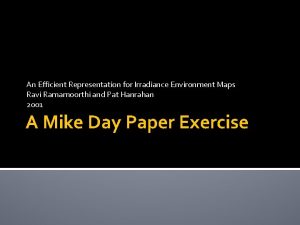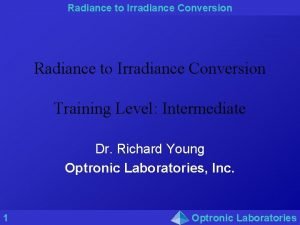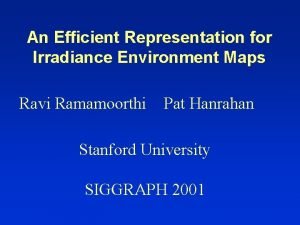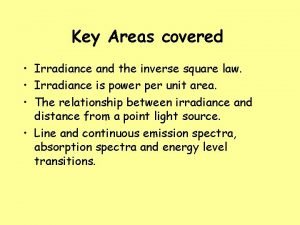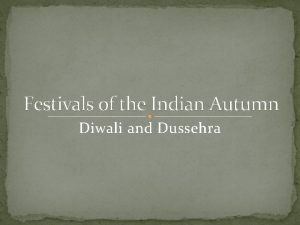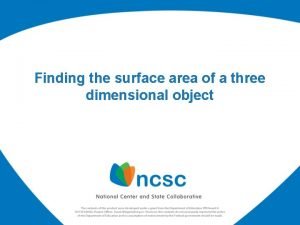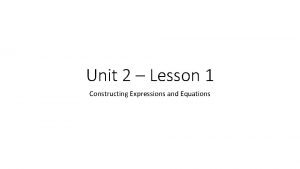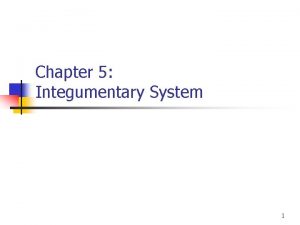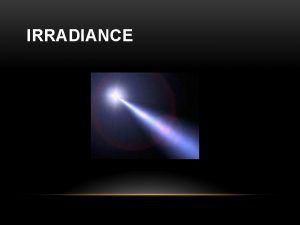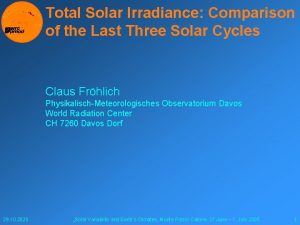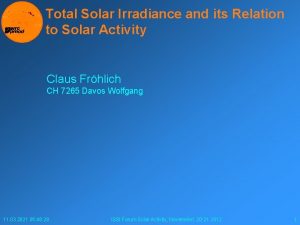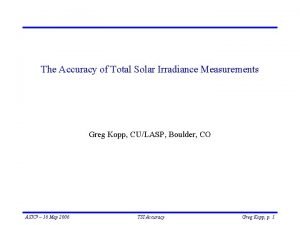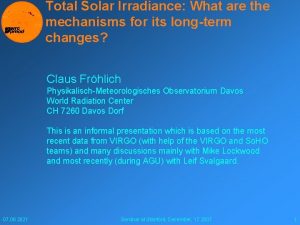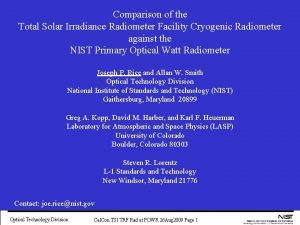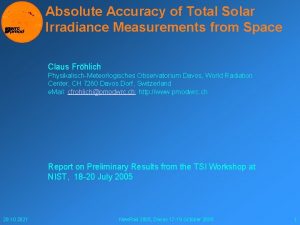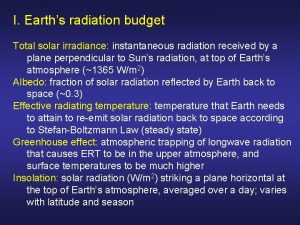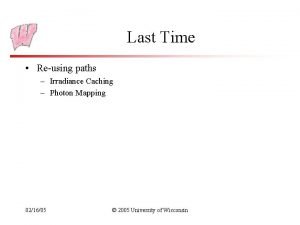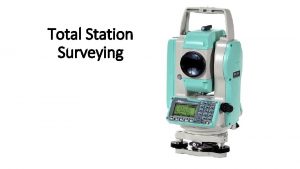Total Solar Irradiance during the last three Solar

















- Slides: 17

Total Solar Irradiance during the last three Solar Cycles: What can we learn about the Mechanisms on the Sun and the Influence on Earth Climate Claus Fröhlich Physikalisch-Meteorlogisches Observatorium Davos, World Radiation Center, CH 7260 Davos Dorf, Switzerland e. Mail: cfrohlich@pmodwrc. ch; http: //www. pmodwrc. ch 03. 12. 2020 „Challenges for Cycle 24“, Ahmedabad, 22 -26 January 2007 1

Construction of a Composite (1 of 4) We have reliable TSI observations since the launch of Nimbus-7. These measurements by HF were followed by ACRIM-I on SMM, ERBE on ERBS, ACRIM-II on UARS, VIRGO on So. HO and ACRIM-III on ACRIM-Sat. And more recently by TIM on SORCE. The absolute uncertainty of the individual radiometers early on was only about 0. 3% (mainly determined by the uncertainty of the aperture area), it decreased in present days to about 0. 1%. However, the picture changed dramatically after the launch of SORCE, when its radiometer showed a value of 0. 4% below the present cluster. 03. 12. 2020 „Challenges for Cycle 24“, Ahmedabad, 22 -26 January 2007 2

Construction of a Composite (2 of 4) § § § In principle we could just start with the results of the first record, shift it to the level of the next and so on, to get a continuous TSI composite. Almost all records, however, need some corrections which have not been incorporated during the original evaluation. During the evaluation of the VIRGO radiometry we learned a great deal about how radiometers behave in space. This TSI record will now be used to explain how such corrections are determined and how the findings and methods can be applied to the other records. 03. 12. 2020 Early Increase Degradation „Challenges for Cycle 24“, Ahmedabad, 22 -26 January 2007 3

Construction of a Composite (3 of 4) § § § Now with what we learned from VIRGO we can look at ACRIM-I and fix the early increase and the degradation during the spin mode. As next we can treat HF. This is complicated by the fact that there are many slips which are most pro-bably due to operational efffects. The corrections applied are due to an early increase, some degradation and a steady sensitivity increase during the whole mission. Also ACRIM-II needs some corrections. They are mainly due to exchanges of the operational radiometer. 03. 12. 2020 „Challenges for Cycle 24“, Ahmedabad, 22 -26 January 2007 4

Construction of a Composite (4 of 4) The radiometric basis for the PMOD composite is ACRIM-I and ACRIM-II after having been shifted to the level of ACRIM-I. Then we can fill in HF and VIRGO to get the continuous record. Finally we shift it to SARR, via ACRIM-II. 03. 12. 2020 Simple, isn‘t it? „Challenges for Cycle 24“, Ahmedabad, 22 -26 January 2007 5

Comparisons of the composites In order to assess the uncertainty of the long-term behaviour we can compare the PMOD composite to e. g. ACRIM-II/III and TIM on SORCE. We can also compare the composites to ERBS. Here we take into account the early increase we determined for ACRIM-I. A final comparison is with the completely independent Kitt-Peak reconstruction. There is a free parameter, which however cannot change the slope. From all this comparisons we can calculate an average of a possible long-term trend which amounts to 3. 9 2. 1 ppm/a. This is different from zero at the 2 level. A major contribution to this average comes from the comparison with TIM during the last 3 years of 8. 3 0. 7 ppm/a which is about double the average. This needs some further investigation. 03. 12. 2020 „Challenges for Cycle 24“, Ahmedabad, 22 -26 January 2007 6

Discussion of the PMOD Composite For an uncertainty estimate the mean trend relative to other observations was: 3. 9 2. 1 ppm/a or 5. 3 2. 9 m. Wm-2/a, yielding about 55 m. Wm-2/cycle The PMOD composite is available from http: //www. pmodwrc. ch/pmod. php? topic=tsi/composite/Solar. Constant 03. 12. 2020 „Challenges for Cycle 24“, Ahmedabad, 22 -26 January 2007 7

Construction of a Proxy Model for TSI We can build a proxy model from data of sunspot, faculae and network. The sunspots are modelled by PSI, which is determined from the observed area of sunspots, their position on the disk and a contrast which depends on size of the spot. The bright features are deter-mined from the Mg. II index, which is separated into a short and long-term part. Mg. IIst is representing the in-fluence of active regions, that is of faculae and Mg. IIlt is describing the solar cycle modulation, mainly by the network. The latter is a consequence of the difference of the coefficients which is due to the difference in the specific contrast of faculae and the network. 03. 12. 2020 Butterfly Diagram of PSI 118. 27 125. 25 127. 03 79. 33 94. 56 94. 14 1. 0001 1. 1591 1. 2414 „Challenges for Cycle 24“, Ahmedabad, 22 -26 January 2007 8

TSI and low-Degree p Modes § § § Here we compare TSI with frequency changes of low order p modes (l = 0… 2, n = 21… 24). The data are from the ground network BISON and from VIRGO (3 - channel SPM and LOI) on So. HO. When we started this analysis in 2001 we were quite pleased with the good correlation we found between TSI+PS-PFs. Last year we extended the analysis and found some important differences during the descending phase of the cycle which indicate that there are some important differences in the reaction to activity. 03. 12. 2020 „Challenges for Cycle 24“, Ahmedabad, 22 -26 January 2007 9

Comparison of TSI with the Proxy Model As the Mg. II index does not show the same limb brightening as faculae we need to use different kernel functions (camel and dromedary) for the PSI corrected TSI and Mg. IIst when we calibrate Mg. II. With this we can now apply the model. It seems that model (Mg. IIlt) may have a problem during cycle 23. Part of the discrepancy will disappear with the new version of the VIRGO data. The correlation is indeed very high with 83% of the variance explained. The assumption that a linear relationship seems appropriate over a solar cycle timescales although we have some deviations on shorter timescales. The correlation without the camel-dromedary method is smaller with 2 0. 79. 03. 12. 2020 „Challenges for Cycle 24“, Ahmedabad, 22 -26 January 2007 10

Extending the Composite As the model goes back to the minimum between cycles 20 and 21 and as it reproduces TSI quite well, we can expand the composite back to 1975. 03. 12. 2020 „Challenges for Cycle 24“, Ahmedabad, 22 -26 January 2007 11

Solar Influence on the Earth’ Climate § § Changes of climate related to the 11 -year cycle can be identified and modeled, especially if the effect of the UV is taken into account. On longer terms the coincidence of the ‘Little Ice Age’ with the Maunder Minimum MM of solar activity in the 17 th century has led to many speculations, that the changes of the solar output – mainly irradiance – may have been the reason. If one uses available reconstructions of TSI for the last thousend years as input to the ‘upwelling-diffusion energy balance climate model’ of Tom Wigley the idea seems to work back to the MM, but the medieval high is not reproduced. So we need to know more about and better understand the influence of solar activity on irradiance – total and spectral. 03. 12. 2020 „Challenges for Cycle 24“, Ahmedabad, 22 -26 January 2007 12

Comparison of the Variability of the three Cycles The difference between the mean and mode provides information about the distribution of the variance. As the faculae increase and sunspot decrease TSI, the mode should be at the separation of the two effects. We also compare the separation found from the mode with the values from the proxy model. 03. 12. 2020 „Challenges for Cycle 24“, Ahmedabad, 22 -26 January 2007 13

How well can we reconstruct TSI from Sunspot Numbers Sunspot numbers are used in reconstructions of TSI into the past. So it is interesting to see how they correlate. For the amplitude of the cycle it seems to have worked quite well for cycles 21 and 22, but 23 is obviously different. Another question is how well can we reproduce the active region modulation with the sunspot number. 03. 12. 2020 „Challenges for Cycle 24“, Ahmedabad, 22 -26 January 2007 14

Conclusions § § § § 03. 12. 2020 With the PMOD composite we have a reliable TSI record for the last three solar cycles. The main result is that there is no trend over this period of time. Both the solar-rotation and the 11 -year-cycle variations are due to the activity related magnetic fields at the photosphere and above. There is still no evidence for changes deeper in the sun with activity. This is supported by the success of the proxy model and reconstruction from magnetograms (talk on Tuesday by N. Krivova). The darkening by sunspots and the brightening by faculae is dominant at timescales of solar rotation (active regions). The 11 -year cycle on the other hand is mainly due to the network in and outside active regions. Although the models explain about 80% of the TSI variance, there are still subtle differences which need explanation. It seems difficult to correlate TSI with activity indices such as the sunspot number (SSN). During cycles 21 and 22 it works quite well, during 23 it faded away. This should be taken seriously for the reconstruction of TSI into the past. Sun-climate relations are still controversial. In recent years it was realized that the strongly variable solar UV is very important. It can amplify the direct effect of changes in TSI substantially. Correlation between NH temperature and solar activity represented by sunspot numbers or by reconstructed magnetic fields exist back to the MM. But, the details of how solar irradiance variability is associated with solar activity indices needs still to be understood better. Or, some other effects of solar activity are responsible, e. g. galactic cosmic rays. We need to continue to observe TSI with radiometers from space, preferably from different platforms over cycle 24. This is not only for the continuation of the record which is by itself important, but also to finally understand the details of TSI variation with solar activity. „Challenges for Cycle 24“, Ahmedabad, 22 -26 January 2007 15

That’s it, thanks. 03. 12. 2020 „Challenges for Cycle 24“, Ahmedabad, 22 -26 January 2007 16

03. 12. 2020 „Challenges for Cycle 24“, Ahmedabad, 22 -26 January 2007 17
 Irradiance environment map
Irradiance environment map Radiance to irradiance conversion
Radiance to irradiance conversion An efficient representation for irradiance environment maps
An efficient representation for irradiance environment maps Inverse square law irradiance
Inverse square law irradiance Vray global illumination
Vray global illumination Uafir fórmula
Uafir fórmula Total revenues minus total costs equals
Total revenues minus total costs equals Total revenues minus total costs equals
Total revenues minus total costs equals Total revenues minus total costs equals
Total revenues minus total costs equals Total revenue minus total expenses
Total revenue minus total expenses Uttam
Uttam Whole sale solar
Whole sale solar Inexhaustible source of energy
Inexhaustible source of energy The surface area of a three-dimensional object is
The surface area of a three-dimensional object is Task 1 new shoes
Task 1 new shoes During our lives, we produce three kinds of hair:
During our lives, we produce three kinds of hair: Hình ảnh bộ gõ cơ thể búng tay
Hình ảnh bộ gõ cơ thể búng tay Lp html
Lp html
